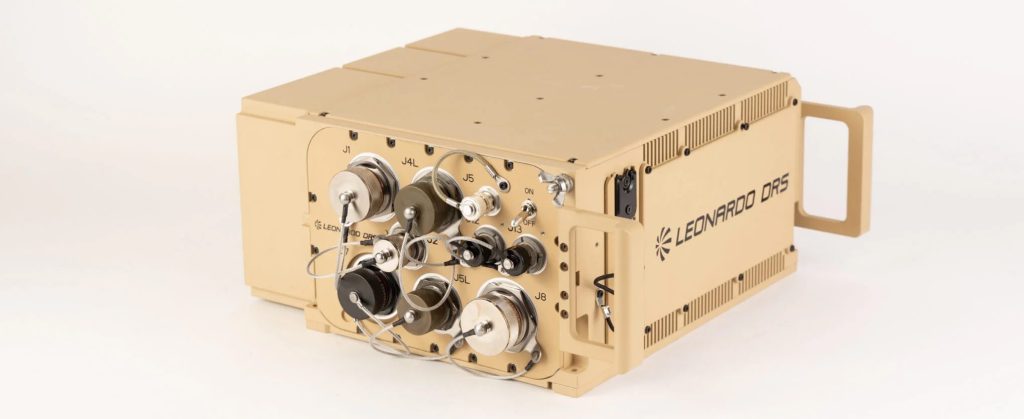
The CMOSS Mounted Form Factor will facilitate tech insertion for new capabilities while co-existing with the Mounted Family of Computer Systems.
In this Q&A with Bill Guyan, senior vice president and general manager of Leonardo DRS Land Electronics, we discuss the U.S. Army’s CMFF program, spelled out as C5ISR/EW Modular Open Suite of Standards (CMOSS) Mounted Form Factor, which will minimize the need for platform-specific integration and enable fielding of technology upgrades without the need for additional cabling, mounts, or upgrades to the CMFF chassis. Leonardo DRS has announced its intent to compete for the program as the prime and lead systems integrator.
Breaking Defense: What is CMFF and how does it play into Army modernization?

In order to launch CMOSS, the Army has been conducting experiments, exercises, and awarding risk reduction contracts in support of the refinement of requirements and development of what they call the CMOSS Mounted Form Factor, or CMFF. This is the instantiation of the standard in a rugged chassis, which can be mounted into an Army mission platform.
With CMOSS standards, CMFF can support multiple-mission packages that might be required of C5ISR/EW electronics on a platform, anything from computing to assured position, navigation and timing, to communications with software-defined radios, and electronic warfare. Some of the risk-reduction awards will identify the lowest-risk approach to each of the capability cards that will ultimately be needed inside the CMFF.
It’s the Army’s vision that the CMFF will prevent ‘vendor lock’ and will allow it to select the capability cards that go in the box – with those cards not necessarily coming from the supplier of the chassis. Down the road, this will also allow the Army to rapidly swap out cards for the purposes of tech insertion or enhancing capabilities without having to spend a lot of money on non-recurring activities with a lead system integrator or prime.
Breaking Defense: Will CMFF be fielded alongside MFoCS and if so, how is it determined which vehicles get CMFF versus MFoCS?
Guyan: MFOCS and CMFF don’t address the exact same requirements set, but there is some overlap and the answer to that question has not yet been decided by the Army. Part of what they’re doing is understanding the capabilities that can be delivered by CMFF, whether it will meet mission requirements while providing the desired flexibility, and the affordability of fielding and maintaining that capability.
Ultimately, given the myriad priorities that the Army’s facing, it will have to make decisions about the initial entry point of fielded CMFF capabilities and their desired objective end state of CMFF capability. We can imagine that like any large program, it will take some years for the full objective capability to have been delivered out into the field. As requirements and technologies continue to evolve, I would expect CMFF to continue evolving as well.
Certainly in the near term and midterm, you would expect to see the legacy or enduring capabilities provided by, for example, the Mounted Family of Computer Systems (MFOCS), coexisting in the network with fielded CMFF capabilities. It’s very possible that that coexistence, or a mixed-fleet, could be the enduring end state due to affordability and mission requirements..
Not all vehicles today need the wide range of capabilities that CMFF might be able to deliver. Just for cost-effectiveness reasons, the Army might elect to only have a small percentage of the fleet equipped with the higher-end CMFF capability, while the lion’s share of the fleet still has the more arguably cost-effective capability that is already being fielded today.
Breaking Defense: Leonardo DRS is announcing its intention to compete as a lead systems integrator for CMFF at AUSA Global Force in Huntsville. Why do you consider Leonardo DRS as the best partner to provide CMFF to the Army?
Guyan: We’ve partnered with the Army for more than 20 years since it embarked on its effort to digitize their forces with a program called Force XXI Battle Command Brigade and Below, or FBCB2. We were selected as the designer, developer, and manufacturer of, first, the V-4 chassis, then the EV-4 chassis, and then the JV-5 chassis – more than 160,000 of which were fielded across the Army, Marine Corps, and National Guard. Making the network accessible in a reliable, dependable way for our soldiers – while they’re in their platforms on the move – is part of our DNA.
As the Army elects to fast-forward and adopt the CMOSS standards and push toward greater convergence of capabilities into the same chassis, ultimately, the engineering challenge is still the same, and that is the sweet spot of our business, which is designing and producing reliable, rugged, cost-effective platform computing solutions that the Army’s soldiers can depend upon to meet their needs for today and for tomorrow.
We see CMFF as an extension of an ecosystem of systems that we’ve already designed, produced, delivered, and are out in the field. We think we have the proven credentials to take on a task like this in a low-risk way and as a trusted partner.
CMFF is a multi-faceted set of converged capabilities and we are building a team of best-in-breed companies to work together with DRS to design and deliver a best-value solution that meets Army’s requirements and achieves the Army’s vision.

Breaking Defense: As a plug-and-play solution, CMFF is agile by nature. How does Leonardo DRS’s agility play into creating this system of systems?
Guyan: In every instance, when we design a product to meet customer requirements, we’re also thinking about what emerging or new capability requirements that customer may also have so we can ‘future-proof’ our design. By understanding our customer needs and the evolution of requirements for the battlefield, we’re able to not only design products which meet the initial requirements, but also deliver products which have the built-in capability to support technology and capability insertion – demonstrating agility and adjusting to meet emerging and evolving operational requirements.
Our earlier fielded versions of the FBCB2 computer originally didn’t have embedded GPS, and we were able to accommodate the insertion of the SAASM GPS in a very agile way.
The architecture was also in a MOSA-like standard card configuration, which allowed us to rapidly adapt and adopt the latest technology evolution of commercial processing, so that the computer that we were delivering was never the weakest point in any network architecture.
We’ve also been able to continue to adapt and insert the capabilities that have come with industry improvements in COTS storage, moving from rotating drive to solid state drive, leveraging latest processor technologies, enhanced cyber protection and multi-touch screens for the soldier interface. We just started deliveries of enhanced MFOCS-2 systems featuring the new embedded MGUE (Military GPS User Equipment) – a foundational piece of Assured Position Navigation and Timing (A-PNT) capabilities
These products were not originally required to have any of these capabilities, but our design was specifically baselined to enable the agile insertion of new capabilities and the adoption of new technologies so that our systems would be able to continue to be relevant and relied upon by our customers.
Breaking Defense: How does this experience translate into a CMFF solution for the future?
Guyan: As we’re getting ready to embark on the next generation of rugged processing for platforms, we’re also celebrating a very important milestone, which is the successful delivery of more than 100,000 of our trusted MFoCS computer systems, currently the backbone of the network in our maneuver force in the Army. It’s the largest and most noteworthy of examples.
Aside from our legacy of deliveries in the U.S. and for the Army, we also have and continue to deliver battle management system solutions for a number of allied and friendly armies around the world. We’re the largest provider of battle management system computing and display solutions in the world, with more than 300,000 of them delivered and still in use today.
Our history and the volume of systems we’ve delivered provide us with peerless experience and unrivaled market access and buying power, so that when it comes to being at the front of the line for the latest technologies from commercial suppliers, we’re right there.
When it comes to having buying power that rivals commercial companies in the acquisition of those technologies, we’re able to pool together our demand from multiple customers and deliver relevant up-to-date and cost-effective solutions to our customers. We intend to leverage all of those strengths in our pursuit of the CMFF program.
Breaking Defense: Final thoughts?
Guyan: Leonardo DRS is committed to continuing to serve as the Army’s partner in its efforts to modernize the force. We are the right trusted partner to take on this task just as we’ve taken on other challenging tasks in this field in the past.
We view our long-standing relationship with the customer as a badge of honor, and one that comes with grave responsibilities. We know that soldiers depend on our systems to be reliable when they’re in harm’s way. Our most important job is making sure that soldiers can depend on our solutions to accomplish their mission and come home.
It’s a high mission that we take seriously, and as the Army embarks on embracing CMOSS, we want to be there as that provider for the Army, for CMFF, so that soldiers in the future can continue to rely upon these new capabilities, as they’ve been able to rely on rugged networking capabilities from Leonardo DRS for decades – and still do today.